|
|
|
|
|
|
|
|
|
On 6 June 1975, a high-speed derailment occurred at Nuneaton as a result of the lights in a gas-lit TSR warning board being extinguished. This accident prompted the British Railways Board to experiment with various improved designs of warning boards and other TSR signage in the years that followed.
|
From c.1975, a type of floodlit warning board was in use that was rectangular in shape but had black markings at either end to form the yellow arrow [14.24]. |
|
From 1976, experimental electric internally illuminated TSR boards (warning boards, speed indicators and termination indicators) went on trial at various sites on the Southern Region.
In 1978, two experimental warning boards were erected near Slough (Western Region) to test their effectiveness. One was equipped with flashing white lights; the other had flashing blue and white lights and blue markings.
Experimental electrically lit warning boards and TSR indicators went on trial at various sites in 1979. The new warning board was rectangular in shape, coloured yellow all over, and displayed two flashing white lights [14.25]. While the speed indication exhibited at the warning board had white figures on a blue background, the colours were transposed on the speed indicator positioned beyond [14.26]. The termination indicator had a white "T" on a blue background [14.27].
A similar set of signs went on trial between Nuneaton and Brinklow (London Midland Region) from December 1979. As this trial progressed into the second half of 1980, the flashing white lights in the warning board (see [14.25]) were, on some occasions, experimentally replaced with steady white lights [14.28], and later, steady yellow lights [14.29].
Further trials of the new signs began on the London Midland Region in July 1980 between London St. Pancras and Bedford. In October 1980, the speed indicators involved in those trials had the colours reversed to white figures on a blue background [14.30], thus matching the speed indication displayed at the warning board (see [14.25]). This colouring was subsequently selected as standard.
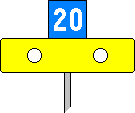 |
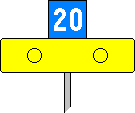 |
 |
|
[14.28] Experimental Electrically Lit Warning Board.
Area: Nuneaton - Brinklow Usage: Low Status: Historical |
[14.29] Experimental Electrically Lit Warning Board.
Area: Nuneaton - Brinklow Usage: Low Status: Historical |
[14.30] Speed Indicator.
Area: All Areas Usage: High Status: Historical |
|---|
When a TSR had been advised in the notices but was not imposed or was withdrawn earlier than published, it had been the practice since January 1977 to erect or retain the TSR boards at the lineside and replace the TSR speed exhibited in both the speed indicator and the warning board with the normal line speed. As an alternative arrangement, it was proposed that the speed indications should be replaced by a special indicator termed a 'spate' indication, 'spate' being an acronym for 'speed previously advised terminated early'. The spate indication, which comprises a diagonal stripe [14.31 & 14.32], was on trial from 1980 and was fully introduced in 1983.
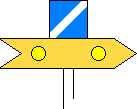 |
 |
|
[14.31] Spate Indication at a Warning Board.
Area: All Areas Usage: High Status: Historical |
[14.32] Spate Indication in lieu of a speed indicator.
Area: All Areas Usage: High Status: Historical |
|---|
When electrically lit TSR signs were adopted for general use in 1981, speed indicators with a blue background (see [14.30]) became the standard form, including those that displayed differential speeds [14.33]. A warning board that referred to a differential speed restriction exhibited both speeds above the yellow plate and flashing lights [14.34]. An electrically lit warning board could display a spate indication in the usual manner [14.35].
 |
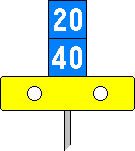 |
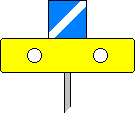 |
|
[14.33] Differential Speed Indicators.
Area: All Areas Usage: High Status: Historical |
[14.34] Electrically Lit Warning Board for a Differential TSR.
Area: All Areas Usage: High Status: Historical |
[14.35] Electrically Lit Warning Board with Spate Indication.
Area: All Areas Usage: High Status: Historical |
|---|
|
The directional indication was on trial from 1982 and introduced as a standard feature in July 1986. This comprised an illuminated arrow indicator [14.36] fitted to a warning board to indicate that the related TSR speed indicator is situated on a left-hand or right-hand divergence ahead. |
|
A temporary speed restriction that has not been advised in the notices, is a lower speed, or applies at a time not shown, is referred to as an 'emergency speed restriction' (ESR). Handsignalmen were originally appointed when an ESR was imposed. If the restriction was to continue for some time, TSR boards were installed at the lineside and the handsignalmen were then withdrawn, apart from the one at the warning board, who had to remain in position until details of the restriction appeared in the notices. This handsignalman was required to place two detonators on the rail and exhibit a yellow handsignal, waved slowly from side to side, for each approaching train. As well as being costly to implement, the noise from the exploding detonators was often the cause of public complaints. Trials commenced in 1982, which entailed a lineside indicator being positioned on the approach to various TSR warning boards (between the warning board and its associated AWS magnet) to assess its effectiveness in giving drivers additional warning of an ESR ahead without the use of a handsignalman. The indicator in these initial trials took the form of a black and white striped board with a central flashing white light [14.37]. A different form of indicator went on trial at Winsford (London Midland Region) in August 1984, comprising two flashing white lights mounted vertically in a blue frame [14.38].
 |
 |
|
[14.37] Experimental Emergency Indicator.
Area: Various Usage: Medium Status: Historical |
[14.38] Experimental Emergency Indicator.
Area: Winsford Usage: Low Status: Historical |
|---|
From 1986, yellow versions of the illuminated TSR signs were on trial [14.39 - 14.46], and gradually they superseded the blue signs formerly used.
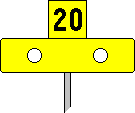 |
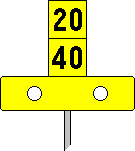 |
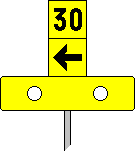 |
|
[14.39] Warning Board.
Area: All Areas Usage: High Status: Historical |
[14.40] Warning Board for a Differential TSR.
Area: All Areas Usage: High Status: Historical |
[14.41] Warning Board with Directional Indication (e.g. applicable to TSR on left-hand divergence).
Area: All Areas Usage: High Status: Historical |
|---|
 |
 |
|
[14.45] Warning Board with Spate Indication.
Area: All Areas Usage: High Status: Historical |
[14.46] Spate Indication in lieu of speed indicator.
Area: All Areas Usage: High Status: Current |
|---|
Following earlier trials of lineside indicators for use on approach to emergency speed restrictions (see [14.37 & 14.38]), further trials took place in 1986 on each of the five British Rail regions. The indicator involved in these trials was positioned adjacent to the AWS equipment on the approach to a TSR warning board, and it comprised a trapezium-shaped board with black and white diagonal stripes and two high-powered flashing white lights [14.47]. Although these trials were successful, a revised style of indicator went on trial in 1987, which was of a similar shape but coloured with yellow and black chevrons [14.48]. This type was introduced for general use in July 1988. Additional AWS equipment is installed on approach to each emergency indicator. A miniature version of the indicator was also introduced, on which the lower black shape is omitted [14.49]. An emergency indicator may be colloquially referred to as a 'Dalek', 'disco board' or 'Metal Mickey'.
|
|
|